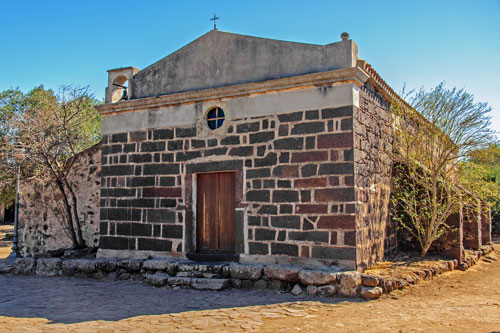Santa Cristina
map of Santa Cristina with the marked sights
The Sacred Well
 The Sacred Well of Santa Cristina is one of the most significant and best-preserved Nuragic well temples in Sardinia.
The Sacred Well of Santa Cristina is one of the most significant and best-preserved Nuragic well temples in Sardinia.
It was built around the 11th century BC. The site was first mentioned in 1857, although its function and significance were not recognized at that time. Major excavations began in 1953 and continued in several stages until 2010.
Within a low outer wall lies the antechamber to the well, where religious ceremonies were likely held. Behind this, the trapezoidal entrance to the actual sanctuary opens up.
 The entrance to the well is at ground level. From here, 25 steps lead down a narrowing staircase.
The entrance to the well is at ground level. From here, 25 steps lead down a narrowing staircase.
The entire architecture is made of hewn and polished basalt blocks. The precision of the construction is impressive.
The stone blocks of the side walls are laid horizontally, forming sloping, nearly flat surfaces that converge upward.
The ceiling of the access is also made of basalt blocks, laid in a staggered manner to form an inverted staircase.
At the bottom, one reaches a circular chamber with a 7-meter-high tholos vault. This vault extends just above the ground surface and has an opening at the top for light to enter.
The floor has a diameter of about 2.5 meters with a 50 cm deep water basin in the center, fed by spring water.
Nothing remains of the well’s above-ground structure (if it ever existed).
Nuragic Settlement
 In the immediate vicinity of the well sanctuary are the remains of Nuragic huts.
In the immediate vicinity of the well sanctuary are the remains of Nuragic huts.
The largest of these is the wall of a round hut with a diameter of about 10 meters. Inside, there is a bench running along the entire wall, and the floor is paved. The roof was originally made of wooden poles and branches. This hut likely served as a communal meeting room.
Next to it are more foundational walls of huts, whose functions are not fully understood. They probably served as dwellings for priests and pilgrims.
Church of Santa Cristina
 The entire Santa Cristina complex is named after this church. The archaeological park spans about 14 hectares.
The entire Santa Cristina complex is named after this church. The archaeological park spans about 14 hectares.
The church was built in the 12th century by monks of the Camaldolese Order. Around the church, there was a Christian settlement.
Over time, numerous renovations and modifications were made, altering the church’s appearance. Only the outer walls remain largely original, incorporating many stone blocks from the ancient well sanctuary.
Since the early 19th century, the church has belonged to the municipality of Paulilatino.
The Pilgrims’ Houses
 Near the church are 36 simple houses called Muristenes or Cumbessias.
Near the church are 36 simple houses called Muristenes or Cumbessias.
These primitive buildings once served as accommodation for monks and later as lodging for pilgrims.
Their use can be traced back to the 13th century. During the Spanish occupation of Sardinia, the use of Muristenes was widespread, although only the wealthy could afford lodging near a church.
The buildings standing today date back to the 18th century and are still used during religious festivals.
The square between the church and the pilgrims’ houses offers lovely shaded picnic spots.
Nuraghe Santa Cristina
 The Nuraghe is located a bit west of the church amid shading trees.
The Nuraghe is located a bit west of the church amid shading trees.
The interior of the impressive structure can be explored, with a narrow staircase leading up from the entrance.
Nearby, a few huts from the Nuragic village are still standing, the largest being about 14 meters long.
As there are few information boards on the entire site, it is advisable to join one of the regular guided tours.
Unfortunately, these tours are mostly offered only in Italian.
Paulilatino, Museum
 The museum visit is included in the Santa Cristina ticket, but it is closed during the siesta.
The museum visit is included in the Santa Cristina ticket, but it is closed during the siesta.
The palazzo dates from the 18th century and was the noble residence of the famous Atzori family.
The last resident was Giovanni Antonio Atzori, the town’s notary, who died in March 1900 at the age of 77.
Later, the house came into the possession of the municipality of Paulilatino, which established a museum here, opened in 1995.

The exhibition is spread over 14 rooms on three floors. At the entrance, visitors receive an audio guide available in multiple languages (including English) that provides information about the exhibits.
The ground floor houses a multimedia archaeological section.
The upper floors feature an ethnographic exhibition. Tools, agricultural equipment, household items, and furniture that were part of Sardinian daily life until about 50 years ago are on display.
Additionally, typical regional clothing and examples of Sardinian bread art, intricate baked works made mainly for religious holidays, can be seen.
How to get there: The museum is located in the historic center of Paulilatino at Via Nazionale 127, about 4 km from Santa Cristina.
It is best to avoid the highway and take the parallel side road into town. Shortly after entering the town, you will come to Via Nazionale and turn left.
